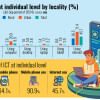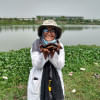Digital divide: The new face of gender inequality

The 67th session of the Commission of the Status of Women (CSW), the largest global intergovernmental forum dedicated to the promotion of gender equality and the empowerment of women, successfully closed its two-week session (March 6-17) with the acknowledgment of the critical role of technology and innovation in achieving gender equality. This year's CSW provided a unique opportunity to have a dialogue on shaping a future where technology contributes to transforming harmful social norms, amplifying women's voices, pushing back against online harassment, promoting safe and equitable usage, and distributing the benefits of digitalisation equally to achieve Sustainable Development Goals (SDGs).
Global data shows that women are 18 percent less likely than men to own a smartphone and far less likely to access or use the internet. While girls perform equally well as boys in science in most countries, just 28 percent of engineering graduates and 22 percent of artificial intelligence (AI) workers worldwide are women. They hold fewer positions globally in the technology industry and are subject to a 21 percent wage disparity. Moreover, nearly half of all women in the IT industry have experienced workplace harassment.
With the converging crises of climate change, costs of living, conflicts, and the Covid pandemic, we are witnessing a reversal in gender equality gains. This has further magnified the unequal pace of digital transformation within and across countries, intensifying systemic barriers for women and girls, including the dangers they face online. As a result, the distance remaining to achieve SDG 5 is even longer.
The integration of a gender perspective in technology and innovation is crucial to the achievement of the 2030 Agenda and the SDGs. The UN secretary-general 's report on the priority theme "Innovation and technological change, and education in the digital age for achieving gender equality and the empowerment of all women and girls" provides an analysis of how to harness technology and innovation for gender equality. It sheds light on four key issues related to Access, Ecosystems, Design, and Safety:
Access – Taking an intersectional approach to ensure meaningful digital access and use that provides unique opportunities and life-long learning experiences that empower women; equal digital learning and skills that are technical as well as transferable; allowing women and girls to be both safe and empowered in their use of technology; and increased representation and leadership of women in STEM education that breaks societal stereotypes.
Ecosystems – Shaping inclusive and transformative innovation ecosystems that require a multidimensional policy framework that considers gender aspects and targets across all dimensions; have targets in place to measure the digital transformation of economies and societies to develop evidence-based policies and programmes; have financial levers such as private sector investments; and a future of work that creates decent jobs that address skill gaps and stereotypes.
Design – Embedding gender perspectives across innovation and technology design, development, and deployment through the assembly of gender-balanced cross-functional teams; adopting a human rights-based approach to prevent, address, and eliminate safety and security risks; and have ethical frameworks and new regulations in place to ensure transparency and accountability in efforts to address unregulated behaviours and standards in ICTs, including the potential harm of products and services and usage of data.
Safety – Preventing and eliminating technology-facilitated gender-based violence (GBV) that requires digital citizenship teaching to counter not only gendered disinformation and sexist hate speech, but also positive values of empathy and ethical use of digital media; improved coherence in policy actions that do not threaten freedom of expression, law enforcement coordination, and expansion and amendment of legal frameworks; and improved accountability of state and non-state actors that accounts for comprehensive data on the prevalence of tech-facilitated GBV and transparent regulatory approaches with regard to the safety of women and girls and digital product design.
In February, a national consultation organised by the Ministry of Women and Children Affairs (MoWCA) supported by UN Women Bangladesh brought together participants from 13 line ministries, civil society representatives, and development partners to provide inputs to the CSW67's draft agreed conclusions. Affirming gender equality to be a constitutional commitment for Bangladesh, Fazilatun Nessa Indira MP, the state minister for MoWCA, stated the government's commitment to increase women's participation in ICT by 30 percent by 2030 and 50 percent by 2041 at the CSW67 Ministerial Roundtable.
For technology and innovation to respond to the needs of women and girls and offer transformative digital solutions, the agreed conclusions endorsed by the member states have the following actionable recommendations that will help strengthen the Smart Bangladesh vision of a knowledge-based and digitally inclusive economy: 1) prioritising digital equity in policies to close the gender digital divide; 2) leveraging financing for inclusive digital transformation and innovation towards achieving gender equality and the empowerment of all women and girls; 3) fostering gender-responsive digital and science and technology education in the digital age; 4) promoting the full, equal and meaningful participation and leadership as well as full employment of women in technology and innovation; 5) adopting gender-responsive technology design, development, and deployment; 6) strengthening fairness, transparency, and accountability in the digital age; 7) enhancing data science to achieve gender equality and the empowerment of all women and girls; and 8) preventing and eliminating all forms of violence, including gender-based violence, that occurs through or is amplified by the use of technologies.
UN Women along with sister UN agencies stands ready to support the Government of Bangladesh and civil society organisations to bridge the gender digital divide, and as the UN Secretary-General António Guterres recently highlighted, "The math is simple: without the insights and creativity of half the world, science and technology will fulfil just half their potential."
Gitanjali Singh is country representative of UN Women in Bangladesh.

 For all latest news, follow The Daily Star's Google News channel.
For all latest news, follow The Daily Star's Google News channel. 











Comments